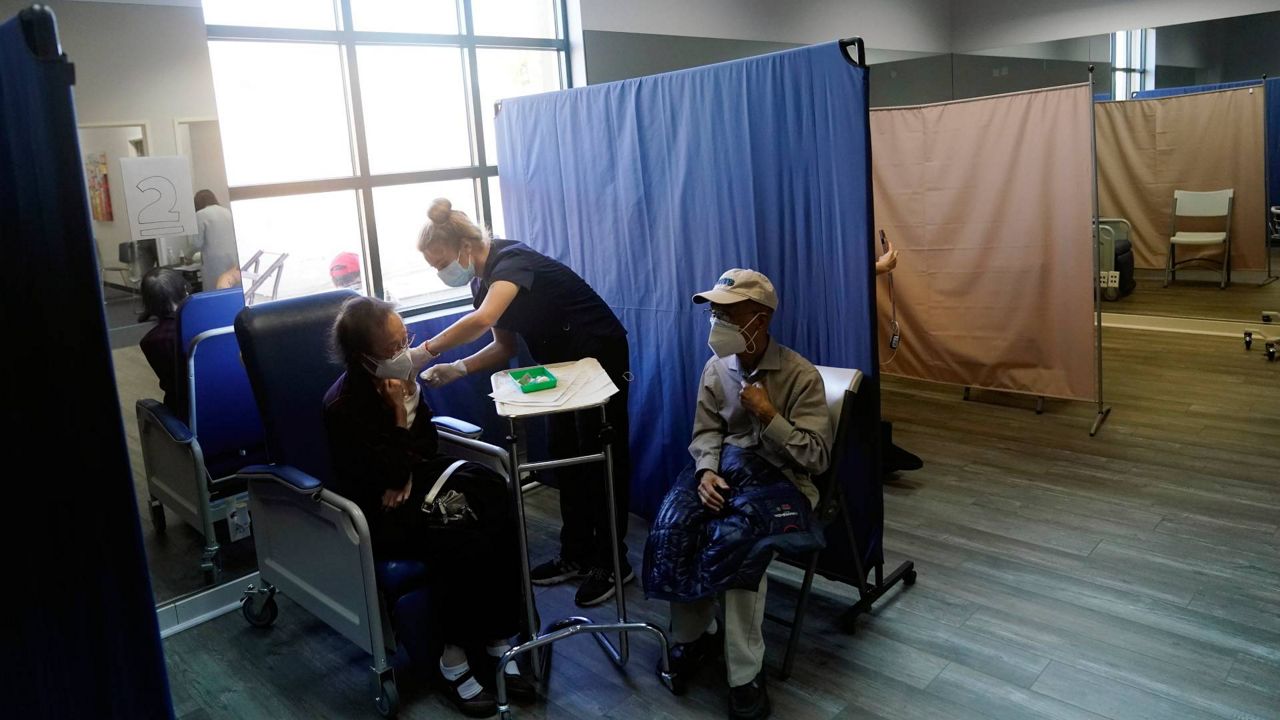SANTA ANA, Calif. (CNS) — Orange County's COVID-19 hospitalizations continued to climb Sunday, rising to 907 — up from 875 Saturday, 779 Friday and 724 Thursday, according to the latest state figures.
The number of those patients in intensive care was 128, up from 116 the previous day.
What You Need To Know
- Orange County's COVID-19 hospitalizations continued to climb Sunday, rising to 907 — up from 875 Saturday
- The number of those patients in intensive care was 128, up from 116 the previous day
- "Our hospitals are full," Dr. Regina Chinsio-Kwong, the county's deputy health officer, said on a weekly media call Friday
- The last time hospitalizations reached that level was mid-February of last year, during a post-holiday winter surge of infections
"Our hospitals are full," Dr. Regina Chinsio-Kwong, the county's deputy health officer, said on a weekly media call Friday.
The last time hospitalizations reached that level was mid-February of last year, during a post-holiday winter surge of infections.
Exactly one year ago — on Jan. 7, 2021 — the all-time record was set for COVID hospitalizations with 2,259 patients, just as vaccines were being rolled out for front-line medical staff and first responders.
Chinsio-Kwong said that with more than 2 million Orange County residents vaccinated, there is a "high likelihood" that many who test positive are not experiencing symptoms. But she added that "ambulance drop-off times are high" at 52 minutes and 36 seconds as of Thursday. Ideally, the time to drop off patients at a hospital should not exceed 30 minutes, she said.
"Most of our hospitals have resurrected their surge tents to handle capacity," she said.
But hospitals are also "experiencing shortages in staff," she said.
"Anywhere from 10 to 20% are calling in sick or having an exposure or coming up positive in COVID tests."
Hospital officials, however, are having difficulty hiring more staff to handle the backlog of patients and may have to appeal to the state for help, she said, adding that other counties have temporarily stopped sending patients to Orange County because the county's 25 hospitals cannot accept any more patients.
"The next step if we continue to have these high drop-off times is some hospitals will have to start thinking about stopping elective procedures," Chinsio-Kwong said.
On Friday, the Orange County Health Care Agency reported 6,428 new positive COVID-19 tests and three additional deaths associated with the virus, bringing the county's cumulative totals to 374,860 cases and 5,906 fatalities.
The OCHCA does not update COVID data on weekends.
All of the deaths logged Friday occurred in December. The death toll for last month is now 57. Chinso-Kwong said 50 of those who died in December were unvaccinated, and the rest were seniors.
Orange County had 18.3% of its intensive care unit patient beds available and 66% of its ventilators as of Friday. Chinsio-Kwong said officials get "nervous" when the ICU bed availability drops below 20%. Of the hospitalized patients, 87% are unvaccinated, and 88% of the ICU patients are not inoculated.
The county's adjusted daily case rate per 100,000 residents jumped from 53.6 Wednesday to 64 Thursday. The testing positivity rate soared up from 16.2% to 19.1%, and it increased from 16% to 19.3% in the health equity quartile, which measures underserved communities hardest hit by the pandemic.
The seven-day average for tests per 100,000 increased from 513.9 Wednesday to 561.2 Thursday.
On Thursday, officials reported a child younger than 5 had died from the disease, the county's third pediatric death of the pandemic.
"We must continue to be mindful of protecting children," Chinsio-Kwong said. "I'm sad to see only 26% have started the vaccination process. I'm hoping more parents will choose to get their children vaccinated."
It's not certain whether the child had been infected with the delta or omicron variant, Chinsio-Kwong said. But she said the omicron variant is having more of an effect on children than previous variants, and she expects pediatric cases to rise locally, mirroring a national trend.
The wave of infections is also affecting entertainment and courthouse functions.
In Orange County's jails, the number of infected inmates rose from 66 on Monday to 103 as of Friday, according to Carrie Braun, a spokeswoman for the Orange County Sheriff's Department. Of those, 25 were newly booked inmates, and the rest were in the general population.
Of the department's 3,800 employees, 214 were infected, Braun said.
Soka Performing Arts Center is postponing its season-opening by two weeks. Officials at South Coast Repertory in Costa Mesa canceled live performances for Saturday and Sunday because some of its theater company has tested positive for coronavirus. The theater hopes to resume performances on Jan. 16.
At the Orange County Superior Courts, attorneys were being encouraged to do more virtual appearances for most hearings, reserving live appearances for evidentiary hearings and trials.
Gov. Gavin Newsom on Saturday unveiled a proposed $2.7 billion COVID-19 emergency response package as part of his next budget proposal, including a $1.4 billion emergency appropriation request to bolster testing capacity, accelerate vaccination and booster efforts, support front-line workers, strengthen the health care system and "battle misinformation."
On Friday, Newsom announced the activation of the California National Guard to help provide additional testing facilities and capacity amid the national surge in cases driven by the omicron variant.



